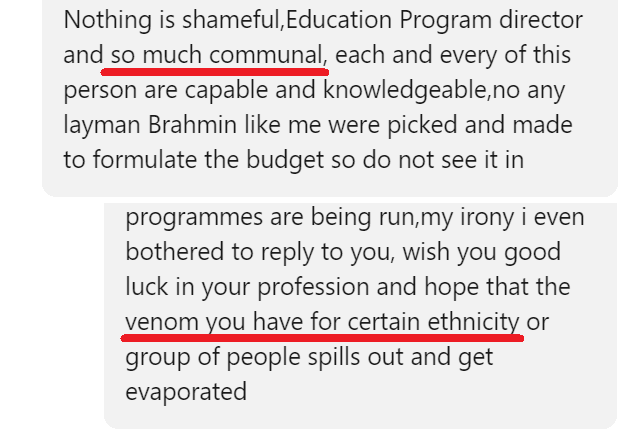
Since returning to Nepal in 2013, I have been actively exposing the structural issues Nepal suffers from, among other things. To do so, I have collated and analyzed data and information available in the public domain, and presented them in ways that are easier to interpret and draw conclusions from. Notably data about the composition by ethnicity and/or caste and gender of important bodies in the country.
One of the first times I created such a chart and shared on social media, in 2015, I was accused of doing a number of different things. I have reproduced many of them in the blog post A Graph is Worth a Thousand Words…It Seems. Since then, I have been accused of being a “racist”. I have been accused of “promoting schism” between peoples of the country. I have been accused of “pointing fingers” at and “blaming” the Khas-aryas (the hill so-called High Caste Hindus) for my own “failures” and/or “suffering,” and those of Nepali society. I have also been accused of believing that they are the “enemies” (see tweet below).
Here’s @ProfessorYello2
— Dorje Gurung, ScD (h.c.) (@Dorje_sDooing) July 13, 2020
a “Hindu Nationalist” (image 1),
who is convinced that I “hate”
some castes & consider them
(mainly Brahmins really) to be my
“enemy” (texts underlined in red
in other images ). And yet, look at
his language (in red) … + pic.twitter.com/bdxU8sADYO
I “hate” them too! The image below is another typical and very recent example.
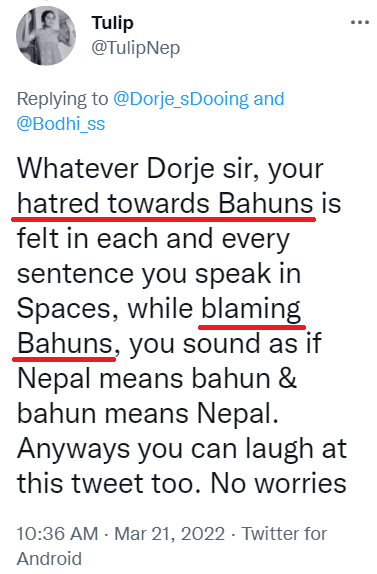
Many of those accusations and characterizations came from Nepalis who appeared to have advanced degrees, able to communicate in English, and, in many cases, even potentially educated as well as residing abroad, permanently!
In the exchanges I reproduce below, I was accused by a hill so-called High Caste Hindu (Bahun/Brahmin) man, an Assistant Professor at a Medical College no less, of being “communal” and having “venom…for certain ethnicity.”
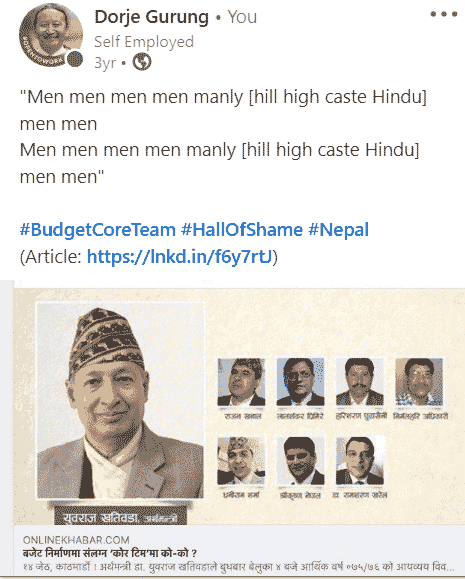
The Professor initiated the exchange by asking me a question, which was pretty innocuous. “Why shame man??” he asked.

That response of mine to his question brought out the reason he had engaged with the post. He retorts by saying, “Nothing is shameful, Education Program director and so much communal[.]” (The Education Program Director was in reference to my title at the NGO I was co-directing at the time.) So I let him have it.
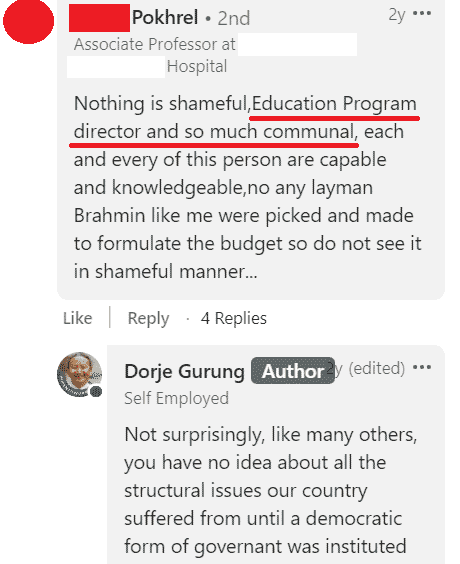
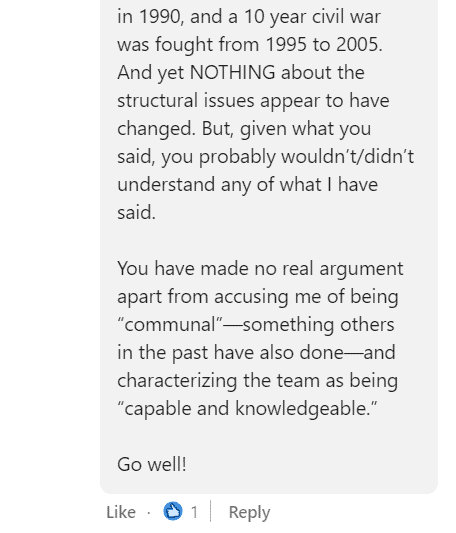
And sadly, when he responded to that, he exposed his lack of knowledge about and understanding of structural issues as well as his inability to express himself sufficiently well in English for me to understand what he was saying.
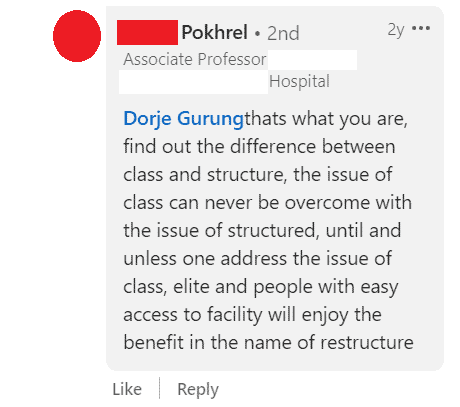
Taking some liberty here with his texts, he seemed to allude to class as the source of structural issues in the country. In Nepal (economic) class and caste are kind of synonymous because of the casteist history of the country. That is, on average the Bahun-Chhetri-Newa (BCN) trio of ethnic groups make more money and are wealthier than the rest. Bahuns and Chhetris being the so-called High Castes. (Newas because they are indigenous to Kathmandu Valley.)
So, in my response, I pointed out how his “argument” made no sense and how class in Nepal is really equivalent to caste.
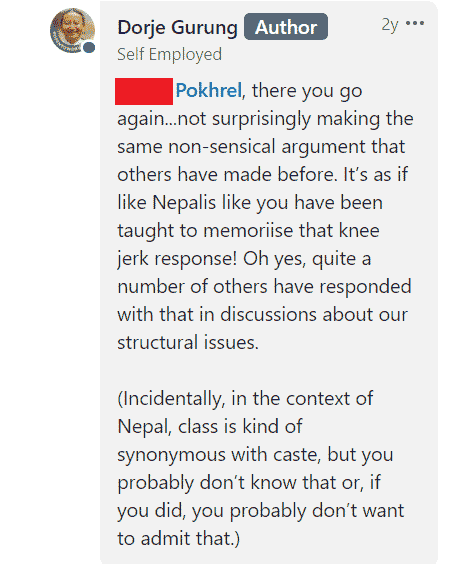
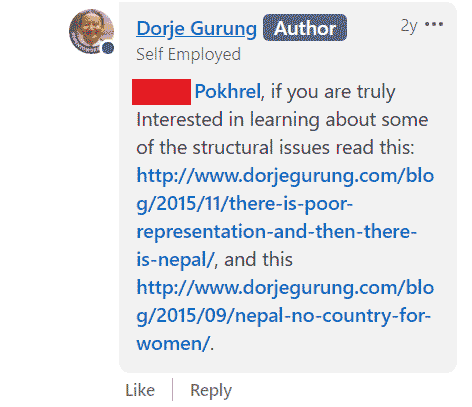
Nepalis I have had discussions with never fail to point out how, were we to raise the economic status of the population, structural issues will be addressed! What they appear to (willfully?) be blind to is the fact that caste-based as well as caste-driven systemic and institutional discrimination has been and continues to be endemic. That is, Nepali individuals as well as systems and institutions in the country discriminate fellow Nepalis based on their caste (and gender) regardless of their wealth. Sure, the discrimination and/or exclusion — from the social, economic, and political structures — of the wealthy so-called lower castes are a lot more subtle than that of the poor so-called lower castes.
Anyway, the Professor who doesn’t even seem to have understood the subject, responded with something that others in the past have: “you are biased[.]” He even added, “come out of the small thoughts and be broad…” and reinforced his point, “its always a class struggle.”
So, in response, I pointed out the fact that he “lacks knowledge and understanding of the topic” and, realizing the futility in engaging with him, told him that I would NOT be engaging with him anymore!
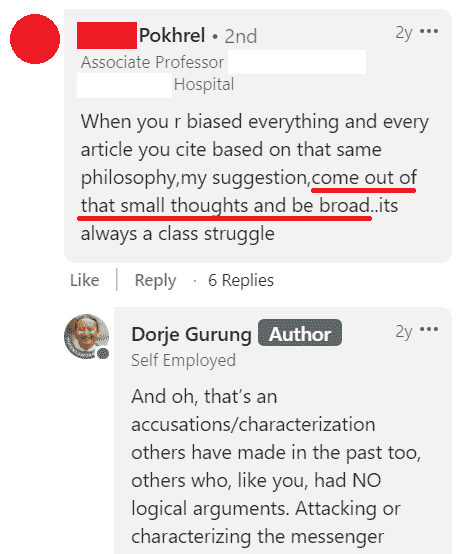
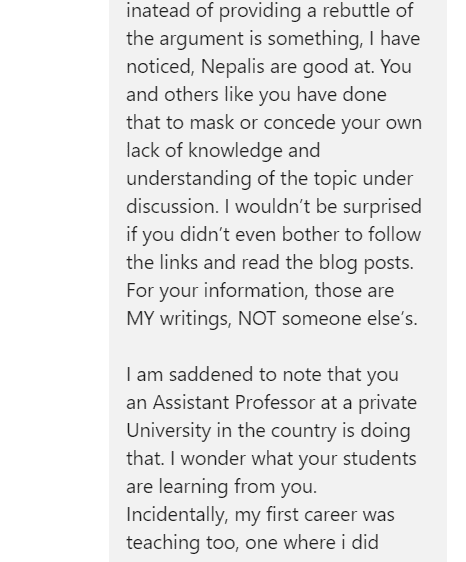
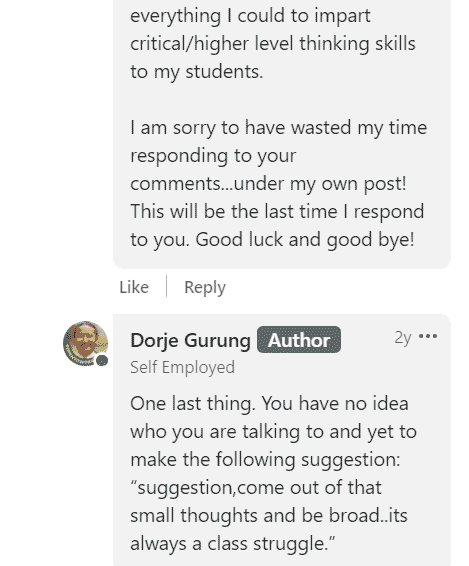

Ranjitkar, a Newa man chimed in saying, ‘”Come out of your small thought” re ha ha. Look who is talking.’
I wasn’t the only one who believed that engaging with this Professor was a waste of time. This user added, “Yes it is a complete waste of time[.]” The professor responded too but, again, based on what he said, I am not sure if he got what we were saying!
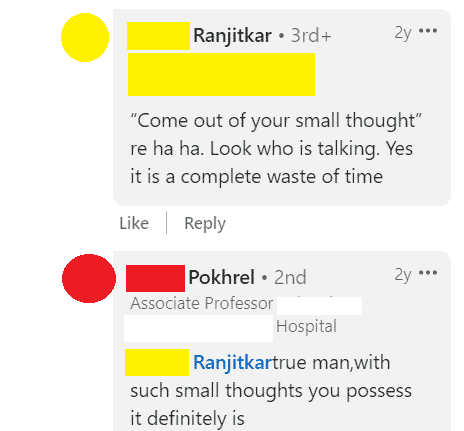
Not content with that, the Professor, following on my own footsteps as it were, commented, “Dorje Gurung sad that you are a program director and i can imagine what kind of program you direct and how the programmes are being run[.]” And then came the personal characterization: I have “venom…for certain ethnicity”! Of course, the ethnicity is Bahun (Brahmin), the most privileged ethnic group in the country.
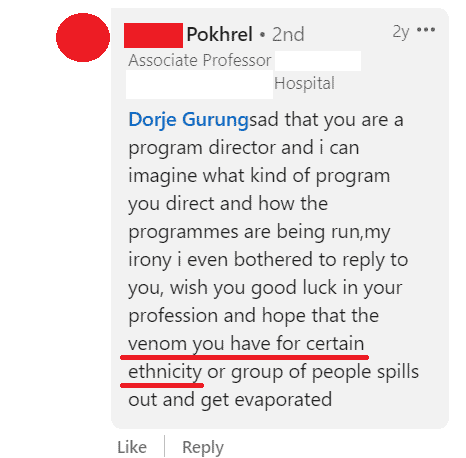
The Newa man added two more comments. First he spelled out the purpose behind what I was doing — pointing out the homogeneity of the group — saying, “It’s not being communial but fairer system for all ethnic groups[.]” He also shared a sobering observation that I have also discovered, “What is really worrying is that so called educated people do not see this as an issue[.]”
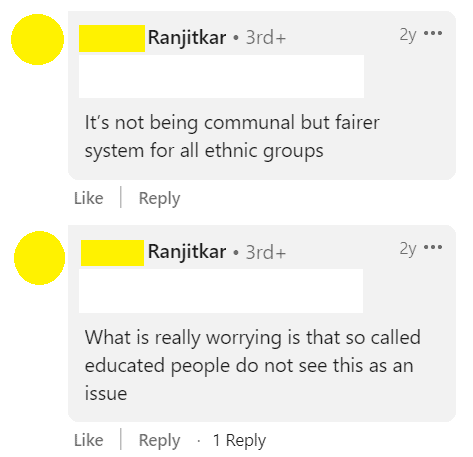
In my response to Ranjitkar, the Newa man, I amplified his sentiment. The Newa man shared, “May be another revolution is coming” in response.
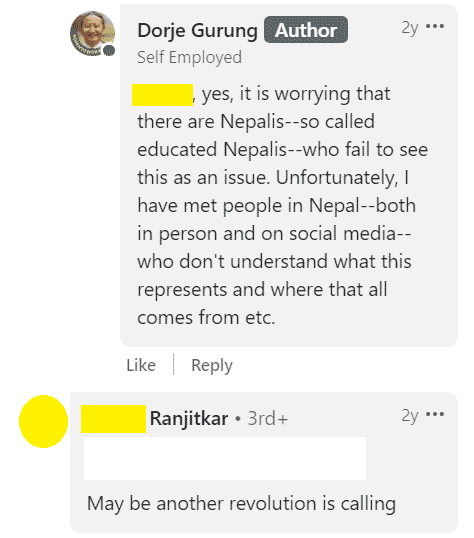
Another Bahun user commented on the original post with hashtags, two of which were just reproductions of those appearing in the original. The important one being the third one: “#WeNeverlearn.” My own counter was, “I don’t think it’s about not learning. I think they don’t care.”
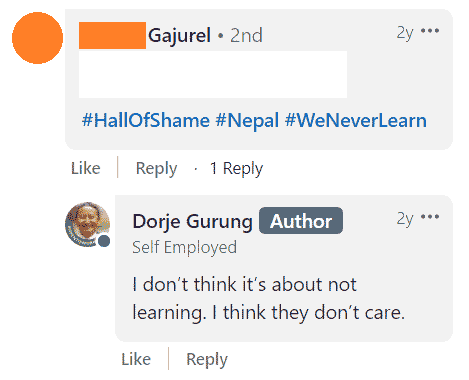
And finally, a Shrestha, a Newa woman responded to the post saying, “That’s diversity right there.” I think she was being sarcastic!
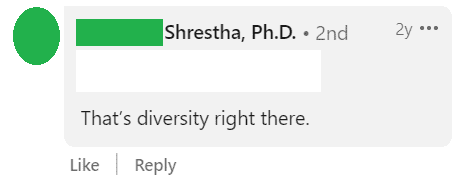
So, where is the Professor (and the twitter users Deepak Raj Neupane, a Bahun, and Tulip, who I also happen to know is a Bahun) coming from? And why does he go on the offensive instead of discussing that which the post is about?
Reproduced below — from Pointing out structural issues in Nepal, to Khas-aryas, is…”pointing fingers” — are the six camps I put hill so-called High Caste Hindus such as them.
As you might have noticed, those who go on the offensive that way, are a motley bunch. I put such hill so-called high caste Hindus in one of six camps, as it were.
Those I put in the first camp are the insecure and thin-skinned ones. They take personally anything that appear to be, or they interpret as, an attack on or negative portrayal of anything connected to — or about — their identity, however loosely.
Those who belong to the second camp are the ones who have a low opinion of the likes of us. Viewing us as inferior, they can’t imagine — or believe in — us being capable of higher purpose in our thoughts, attitudes, beliefs, behaviors, and actions.
Those in the third camp are the uneducated ones. They haven’t been taught and therefore don’t know that the structural issues plaguing the country is a legacy of the casteist history of the country — forget about the role their ancestors played in that history. As a matter of fact, they very likely believe that the history of the country is actually “all glorious and all Nepalis live in social harmony.”
In the fourth camp are the lazy ones. They accuse us of being petty and blaming them for the structural issues because it’s the easier option. Doing so obviates the need for them to think about it at all.
In the fifth camp are the really really stupid and dumb ones. They are the ones who are so stupid and dumb that they view us as being just as stupid and dumb as they are. They are likely not aware of that however; they are after all really stupid! Unable to imagine themselves thinking, saying or doing anything intelligent or sensible etc. were they in our shoes, they are convinced that the only things we are capable of saying and doing etc. about the structural issues plaguing the country are only what they themselves are capable of!
In the sixth and the last camp are those who know and understand exactly what we are doing AND may even feel shame over everything their ancestors have done etc. But arrogance prevents them from admitting to that. Instead they decide to discredit us by belittling us, or by questioning or denouncing our motive, or by insulting our intelligence and intellectual integrity etc.
Which camp do you think the Professor belongs?
For an Assistant Professor — at a medical college in Kathmandu — to view sharing an evidence of the structural issues the country suffers from as being “communal” and having “venom” against the hill so-called high caste Hindus, I am sure there are a number of different reasons. But one of the main reasons, is likely lack of education on the casteist history of the country and its legacy. So he could fall in the third camp.
If he is indeed actually knowledgeable about all that but chose to deflect by making personal attacks, then the man is arrogant and even a little…malicious? He could therefore be said to fall in the sixth camp. He could also be afflicted with the “superiority complex” those belonging to the second camp are!
What do you think?
* * * * * * * *
Additional Materials On the Topic
- When Structural Privilege Blinds and Subtle Internalized Casteism Guides is a reproduction of an exchange on Facebook with another hill so-called High Caste Hindu who displayed similar inclinations as this Professor.
- The Story of Eklavya and Dronarcharya: More of Caste Supremacy Than Model Discipleship
- When Form and Protocol (“Sanskriti”) Generally Take Precedent Over and Is Valued More Than Substance… is about yet another example of Professors this time, old hill so-called High Caste Hindu MEN Professors, convinced that they know more and better than their female peers.
- Nepal: Privilege and Entitlement Fostered Myopic Arrogance of, again, an old hill so-called high caste Hindu man in a position of authority.
- “Putting Someone In Their Place”…Nepalese Style is about a Nepali man who clearly views himself as “superior” to me trying to do just that.

